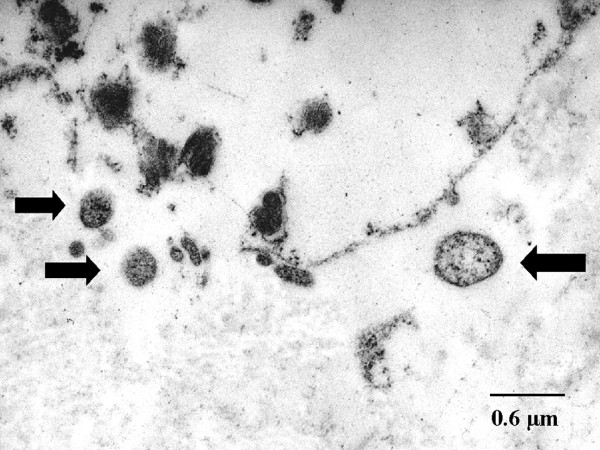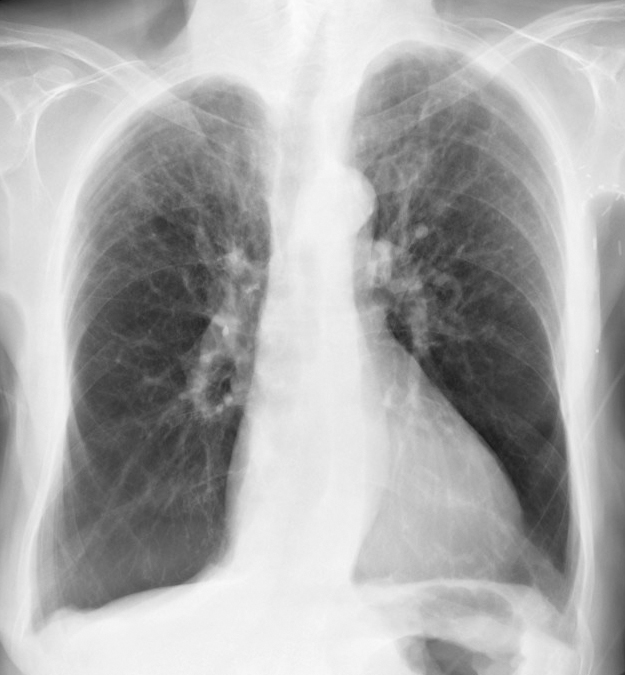[1]
Hersh CP, Campbell EJ, Scott LR, Raby BA. Alpha-1 Antitrypsin Deficiency as an Incidental Finding in Clinical Genetic Testing. American journal of respiratory and critical care medicine. 2019 Jan 15:199(2):246-248. doi: 10.1164/rccm.201809-1679LE. Epub
[PubMed PMID: 30359090]
[2]
Tasch JJ, McLaughlan AT, Nasir AA. A Novel Approach to Screening for Alpha-1 Antitrypsin Deficiency: Inpatient Testing at a Teaching Institution. Chronic obstructive pulmonary diseases (Miami, Fla.). 2018 Apr 1:5(2):106-110. doi: 10.15326/jcopdf.5.2.2017.0170. Epub 2018 Apr 1
[PubMed PMID: 30374448]
[3]
Gramegna A, Aliberti S, Confalonieri M, Corsico A, Richeldi L, Vancheri C, Blasi F. Alpha-1 antitrypsin deficiency as a common treatable mechanism in chronic respiratory disorders and for conditions different from pulmonary emphysema? A commentary on the new European Respiratory Society statement. Multidisciplinary respiratory medicine. 2018:13():39. doi: 10.1186/s40248-018-0153-4. Epub 2018 Oct 8
[PubMed PMID: 30338069]
Level 3 (low-level) evidence
[4]
American Thoracic Society, European Respiratory Society. American Thoracic Society/European Respiratory Society statement: standards for the diagnosis and management of individuals with alpha-1 antitrypsin deficiency. American journal of respiratory and critical care medicine. 2003 Oct 1:168(7):818-900
[PubMed PMID: 14522813]
[5]
Owen MC, Brennan SO, Lewis JH, Carrell RW. Mutation of antitrypsin to antithrombin. alpha 1-antitrypsin Pittsburgh (358 Met leads to Arg), a fatal bleeding disorder. The New England journal of medicine. 1983 Sep 22:309(12):694-8
[PubMed PMID: 6604220]
[6]
Okayama H, Brantly M, Holmes M, Crystal RG. Characterization of the molecular basis of the alpha 1-antitrypsin F allele. American journal of human genetics. 1991 Jun:48(6):1154-8
[PubMed PMID: 2035534]
[7]
Miravitlles M, Turner AM, Torres-Duran M, Tanash H, Rodríguez-García C, López-Campos JL, Chlumsky J, Guimaraes C, Rodríguez-Hermosa JL, Corsico A, Martinez-González C, Hernández-Pérez JM, Bustamante A, Parr DG, Casas-Maldonado F, Hecimovic A, Janssens W, Lara B, Barrecheguren M, González C, Stolk J, Esquinas C, Clarenbach CF, EARCO study investigators. Characteristics of individuals with alpha-1 antitrypsin deficiency from Northern and Southern European countries: EARCO international registry. The European respiratory journal. 2023 Mar:61(3):. pii: 2201949. doi: 10.1183/13993003.01949-2022. Epub 2023 Mar 30
[PubMed PMID: 36997232]
[8]
Curjuric I, Imboden M, Bettschart R, Caviezel S, Dratva J, Pons M, Rothe T, Schmidt-Trucksäss A, Stolz D, Thun GA, von Eckardstein A, Kronenberg F, Ferrarotti I, Probst-Hensch NM. Alpha-1 antitrypsin deficiency: From the lung to the heart? Atherosclerosis. 2018 Mar:270():166-172. doi: 10.1016/j.atherosclerosis.2018.01.042. Epub 2018 Jan 31
[PubMed PMID: 29432934]
[9]
McCarthy C, Lara Gallego B, Trapnell BC, McCormack FX. Epidemiology of Rare Lung Diseases: The Challenges and Opportunities to Improve Research and Knowledge. Advances in experimental medicine and biology. 2017:1031():419-442. doi: 10.1007/978-3-319-67144-4_24. Epub
[PubMed PMID: 29214586]
Level 3 (low-level) evidence
[10]
Strnad P, McElvaney NG, Lomas DA. Alpha(1)-Antitrypsin Deficiency. The New England journal of medicine. 2020 Apr 9:382(15):1443-1455. doi: 10.1056/NEJMra1910234. Epub
[PubMed PMID: 32268028]
[11]
Stoller JK, Aboussouan LS. A review of α1-antitrypsin deficiency. American journal of respiratory and critical care medicine. 2012 Feb 1:185(3):246-59. doi: 10.1164/rccm.201108-1428CI. Epub 2011 Sep 29
[PubMed PMID: 21960536]
[12]
Mahadeva R, Chang WS, Dafforn TR, Oakley DJ, Foreman RC, Calvin J, Wight DG, Lomas DA. Heteropolymerization of S, I, and Z alpha1-antitrypsin and liver cirrhosis. The Journal of clinical investigation. 1999 Apr:103(7):999-1006
[PubMed PMID: 10194472]
[13]
Miravitlles M, Dirksen A, Ferrarotti I, Koblizek V, Lange P, Mahadeva R, McElvaney NG, Parr D, Piitulainen E, Roche N, Stolk J, Thabut G, Turner A, Vogelmeier C, Stockley RA. European Respiratory Society statement: diagnosis and treatment of pulmonary disease in α(1)-antitrypsin deficiency. The European respiratory journal. 2017 Nov:50(5):. pii: 1700610. doi: 10.1183/13993003.00610-2017. Epub 2017 Nov 30
[PubMed PMID: 29191952]
[14]
. A registry of patients with severe deficiency of alpha 1-antitrypsin. Design and methods. The Alpha 1-Antitrypsin Deficiency Registry Study Group. Chest. 1994 Oct:106(4):1223-32
[PubMed PMID: 7924498]
[15]
St Jean P, Hart B, Webster M, Steed D, Adamson J, Powell J, Ferrell R. Alpha-1-antitrypsin deficiency in aneurysmal disease. Human heredity. 1996 Mar-Apr:46(2):92-7
[PubMed PMID: 8666418]
[16]
Schievink WI, Puumala MR, Meyer FB, Raffel C, Katzmann JA, Parisi JE. Giant intracranial aneurysm and fibromuscular dysplasia in an adolescent with alpha 1-antitrypsin deficiency. Journal of neurosurgery. 1996 Sep:85(3):503-6
[PubMed PMID: 8751640]
[17]
Frederick WG, Enriquez R, Bookbinder MJ. Peripheral neuropathy associated with alpha 1-antitrypsin deficiency. Archives of neurology. 1990 Feb:47(2):233-5
[PubMed PMID: 2154173]
[18]
Campos MA, Wanner A, Zhang G, Sandhaus RA. Trends in the diagnosis of symptomatic patients with alpha1-antitrypsin deficiency between 1968 and 2003. Chest. 2005 Sep:128(3):1179-86
[PubMed PMID: 16162704]
[19]
Patel D, Teckman JH. Alpha-1-Antitrypsin Deficiency Liver Disease. Clinics in liver disease. 2018 Nov:22(4):643-655. doi: 10.1016/j.cld.2018.06.010. Epub 2018 Aug 22
[PubMed PMID: 30266154]
[20]
Torres-Durán M, Lopez-Campos JL, Barrecheguren M, Miravitlles M, Martinez-Delgado B, Castillo S, Escribano A, Baloira A, Navarro-Garcia MM, Pellicer D, Bañuls L, Magallón M, Casas F, Dasí F. Alpha-1 antitrypsin deficiency: outstanding questions and future directions. Orphanet journal of rare diseases. 2018 Jul 11:13(1):114. doi: 10.1186/s13023-018-0856-9. Epub 2018 Jul 11
[PubMed PMID: 29996870]
Level 3 (low-level) evidence
[21]
Mayer AS, Stoller JK, Bucher Bartelson B, James Ruttenber A, Sandhaus RA, Newman LS. Occupational exposure risks in individuals with PI*Z alpha(1)-antitrypsin deficiency. American journal of respiratory and critical care medicine. 2000 Aug:162(2 Pt 1):553-8
[PubMed PMID: 10934086]
[22]
Tamondong-Lachica DR, Skolnik N, Hurst JR, Marchetti N, Rabe APJ, Montes de Oca M, Celli BR. GOLD 2023 Update: Implications for Clinical Practice. International journal of chronic obstructive pulmonary disease. 2023:18():745-754. doi: 10.2147/COPD.S404690. Epub 2023 May 5
[PubMed PMID: 37180752]
[23]
Walters JA, Tang JN, Poole P, Wood-Baker R. Pneumococcal vaccines for preventing pneumonia in chronic obstructive pulmonary disease. The Cochrane database of systematic reviews. 2017 Jan 24:1(1):CD001390. doi: 10.1002/14651858.CD001390.pub4. Epub 2017 Jan 24
[PubMed PMID: 28116747]
Level 1 (high-level) evidence
[24]
Alison JA, McKeough ZJ, Johnston K, McNamara RJ, Spencer LM, Jenkins SC, Hill CJ, McDonald VM, Frith P, Cafarella P, Brooke M, Cameron-Tucker HL, Candy S, Cecins N, Chan AS, Dale MT, Dowman LM, Granger C, Halloran S, Jung P, Lee AL, Leung R, Matulick T, Osadnik C, Roberts M, Walsh J, Wootton S, Holland AE, Lung Foundation Australia and the Thoracic Society of Australia and New Zealand. Australian and New Zealand Pulmonary Rehabilitation Guidelines. Respirology (Carlton, Vic.). 2017 May:22(4):800-819. doi: 10.1111/resp.13025. Epub 2017 Mar 24
[PubMed PMID: 28339144]
[25]
Luna Diaz LV, Iupe I, Zavala B, Balestrini KC, Guerrero A, Holt G, Calderon-Candelario R, Mirsaeidi M, Campos M. Improving adherence to alpha-1 antitrypsin deficiency screening guidelines using the pulmonary function laboratory. International journal of chronic obstructive pulmonary disease. 2017:12():2257-2259. doi: 10.2147/COPD.S143424. Epub 2017 Jul 31
[PubMed PMID: 28814853]
[26]
Campos M, Lascano J. Therapeutics: Alpha-1 Antitrypsin Augmentation Therapy. Methods in molecular biology (Clifton, N.J.). 2017:1639():249-262. doi: 10.1007/978-1-4939-7163-3_25. Epub
[PubMed PMID: 28752465]
[27]
Kueppers F, Sanders C. State-of-the-art testing for alpha-1 antitrypsin deficiency. Allergy and asthma proceedings. 2017 Mar 24:38(2):108-114. doi: 10.2500/aap.2017.38.4031. Epub 2017 Jan 24
[PubMed PMID: 28120746]
[28]
McElvaney NG, Burdon J, Holmes M, Glanville A, Wark PA, Thompson PJ, Hernandez P, Chlumsky J, Teschler H, Ficker JH, Seersholm N, Altraja A, Mäkitaro R, Chorostowska-Wynimko J, Sanak M, Stoicescu PI, Piitulainen E, Vit O, Wencker M, Tortorici MA, Fries M, Edelman JM, Chapman KR, RAPID Extension Trial Group. Long-term efficacy and safety of α1 proteinase inhibitor treatment for emphysema caused by severe α1 antitrypsin deficiency: an open-label extension trial (RAPID-OLE). The Lancet. Respiratory medicine. 2017 Jan:5(1):51-60. doi: 10.1016/S2213-2600(16)30430-1. Epub 2016 Dec 2
[PubMed PMID: 27916480]
[29]
Dummer J, Dobler CC, Holmes M, Chambers D, Yang IA, Parkin L, Smith S, Wark P, Dev A, Hodge S, Dabscheck E, Gooi J, Samuel S, Knowles S, Holland AE. Diagnosis and treatment of lung disease associated with alpha one-antitrypsin deficiency: A position statement from the Thoracic Society of Australia and New Zealand. Respirology (Carlton, Vic.). 2020 Mar:25(3):321-335. doi: 10.1111/resp.13774. Epub 2020 Feb 6
[PubMed PMID: 32030868]
[30]
Nelson DR, Teckman J, Di Bisceglie AM, Brenner DA. Diagnosis and management of patients with α1-antitrypsin (A1AT) deficiency. Clinical gastroenterology and hepatology : the official clinical practice journal of the American Gastroenterological Association. 2012 Jun:10(6):575-80. doi: 10.1016/j.cgh.2011.12.028. Epub 2011 Dec 23
[PubMed PMID: 22200689]
[31]
Wilke A, Semper H, Gross C, Grohé C. [Longterm Homecare Augmentation Program in Alpha-1-Antitrypsin Deficient Patients]. Pneumologie (Stuttgart, Germany). 2018 Aug:72(8):590-597. doi: 10.1055/a-0618-7493. Epub 2018 Aug 8
[PubMed PMID: 30089330]
[32]
Stockley RA, Edgar RG, Starkey S, Turner AM. Health status decline in α-1 antitrypsin deficiency: a feasible outcome for disease modifying therapies? Respiratory research. 2018 Jul 20:19(1):137. doi: 10.1186/s12931-018-0844-6. Epub 2018 Jul 20
[PubMed PMID: 30029692]
[33]
Silverman EK, Sandhaus RA. Clinical practice. Alpha1-antitrypsin deficiency. The New England journal of medicine. 2009 Jun 25:360(26):2749-57. doi: 10.1056/NEJMcp0900449. Epub
[PubMed PMID: 19553648]


